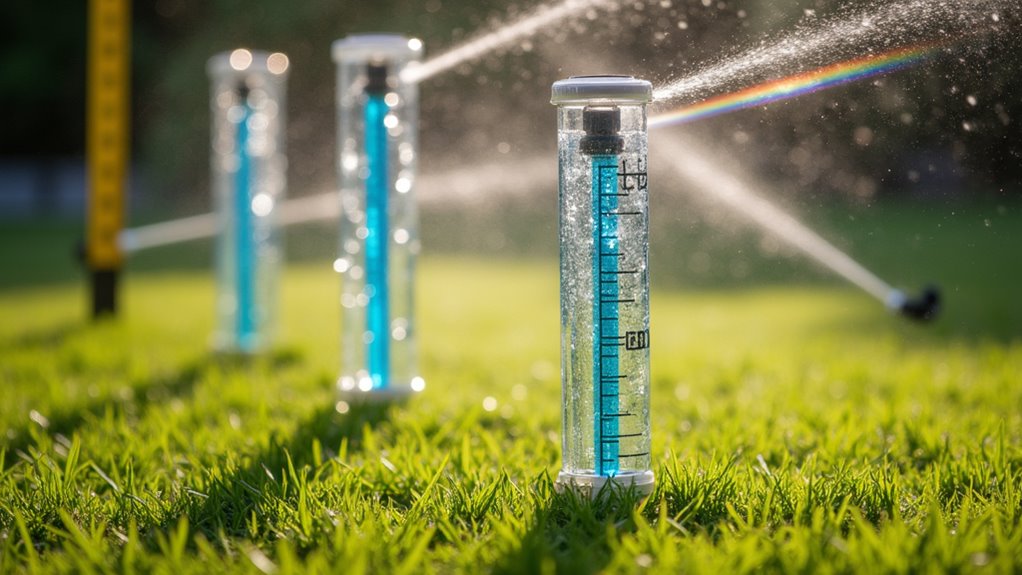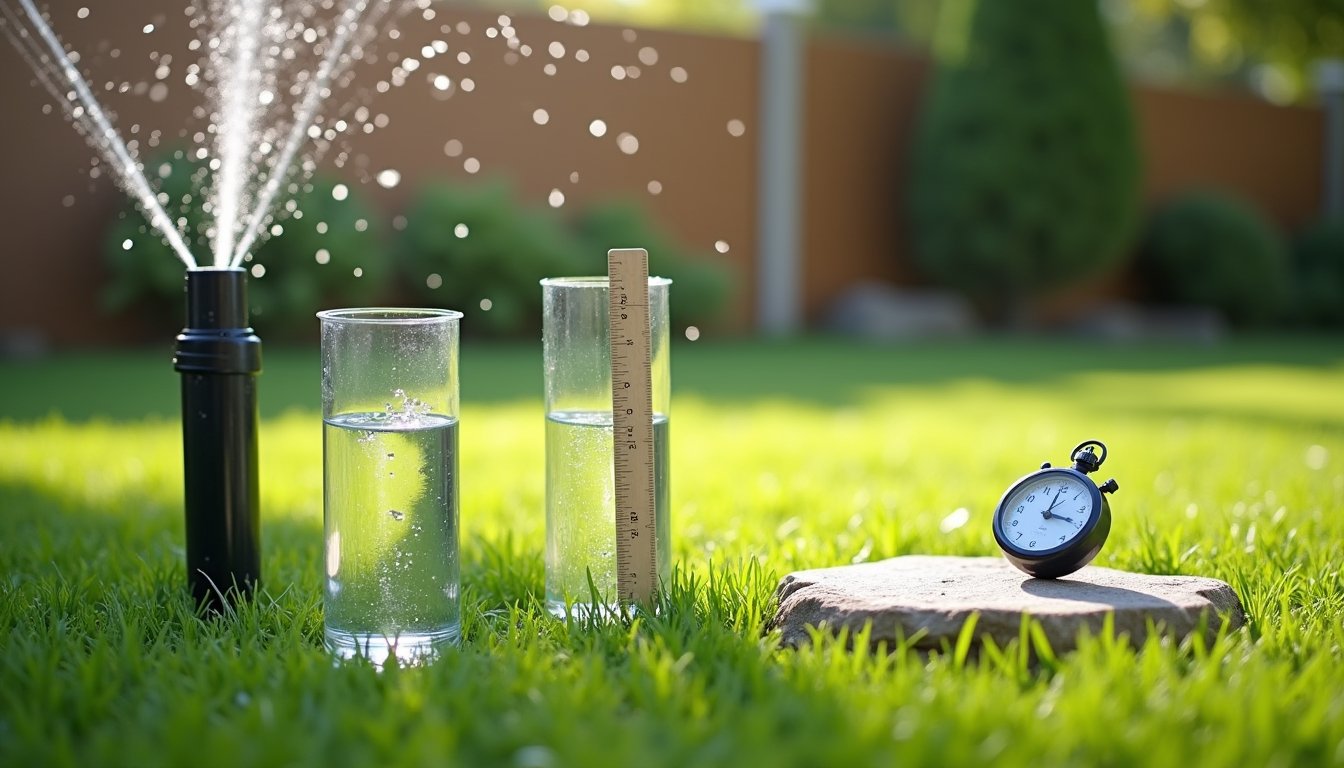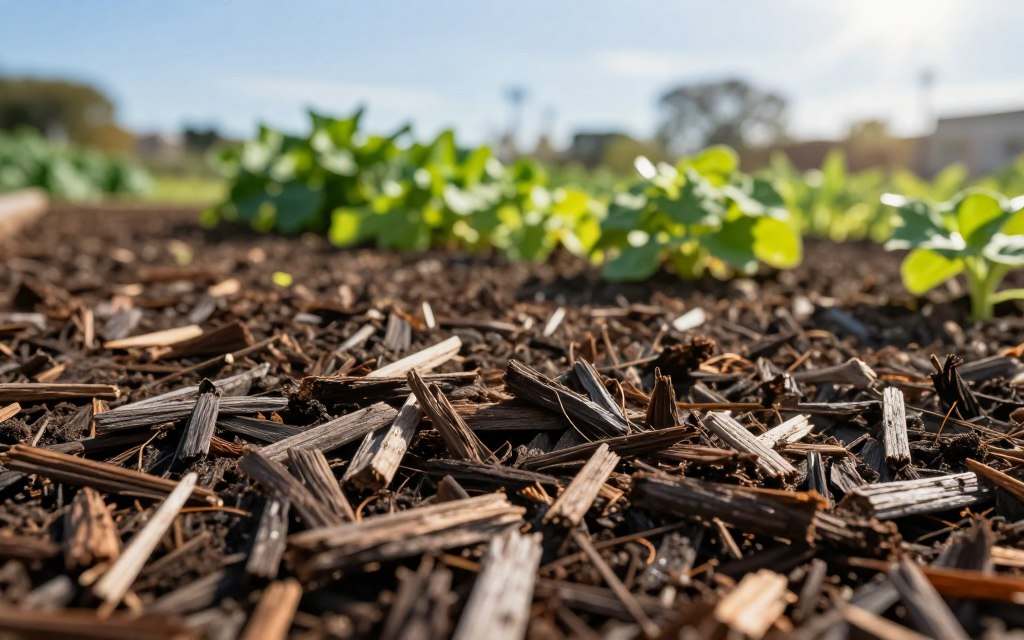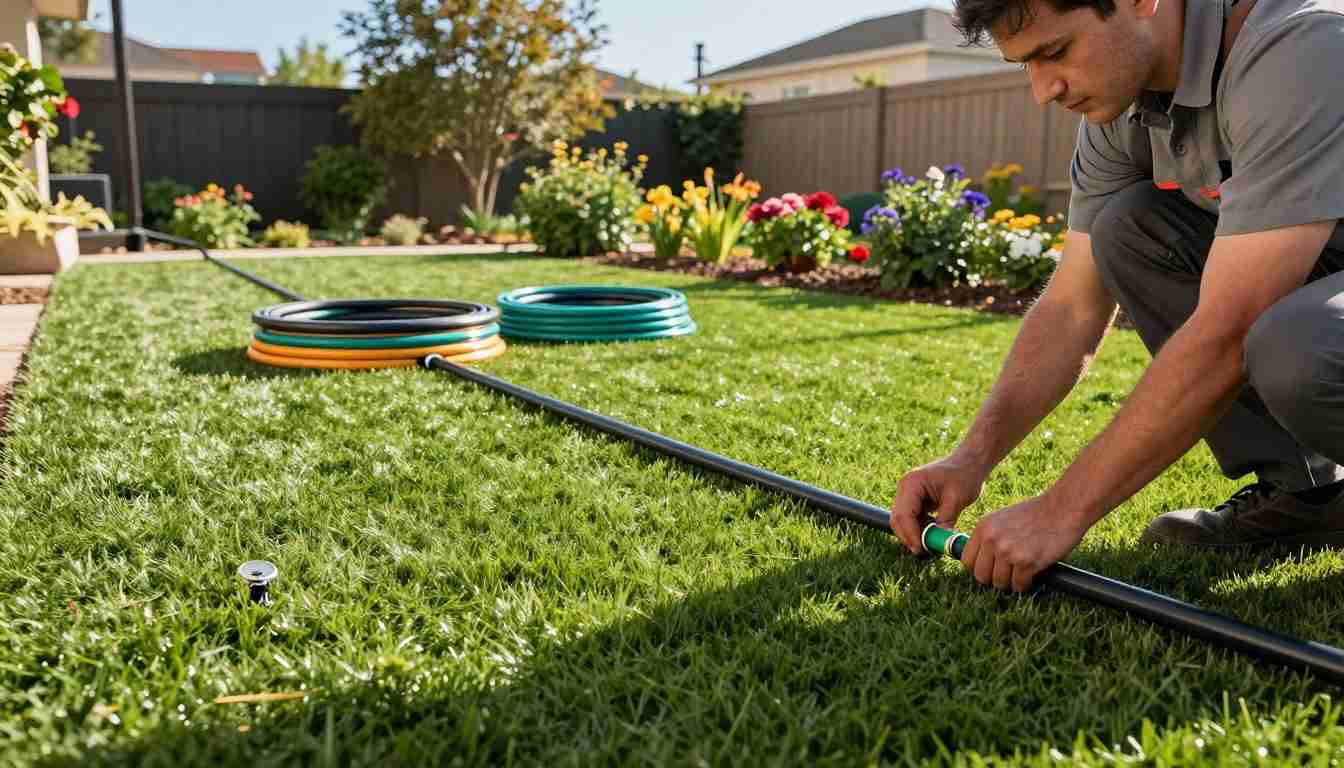To measure lawn irrigation with a water gauge, you’ll need multiple collection vessels, a ruler, and a timer. Place your gauges 1.5-2 feet from sprinkler heads in level, unobstructed areas across different zones. Run your system for 15-30 minutes during calm weather, measuring water depth at consistent intervals. Check for even distribution and adjust coverage as needed. Calculate application rates by dividing water volume by area. These fundamental steps lay the groundwork for precise irrigation management.
Gathering Your Measurement Tools

To accurately measure your lawn’s water intake, you’ll need three essential tools: a ruler for depth measurements, multiple collection vessels (either clean tuna cans or rain gauges), and a timer to track irrigation duration.
When selecting your collection vessels, guarantee they’re uniform in size and shape to maintain consistent measurements. Position these vessels strategically around your sprinkler system’s coverage area, particularly at distances of 1.5-2 feet from each sprinkler head, with supplementary containers placed 1 foot away. This arrangement will help you assess water distribution patterns across your lawn.
Your ruler should have clear, legible markings in both inches and centimeters for precise depth readings. Choose a timer that’s easy to operate and can accurately track 15-minute intervals, as this is the standard duration for initial sprinkler system testing.
Choosing the Right Location for Your Gauge
Where you place your water gauge greatly impacts the accuracy of your irrigation measurements. You’ll need to position your rain gauges strategically to obtain reliable data about your lawn’s water coverage. Make certain you consider both natural and artificial factors that could interfere with accurate readings.
Strategic placement of water gauges is essential for accurate irrigation data, accounting for both natural and artificial interference factors.
- Place gauges at equal distances from sprinkler heads to measure distribution uniformity
- Position gauges away from obstacles like trees, buildings, or tall shrubs that could block water
- Set gauges at the same height as your grass to capture realistic irrigation levels
- Install multiple gauges across different lawn zones to account for variations
- Secure gauges firmly in level ground to prevent tipping or movement during measurement
These placement guidelines will help ascertain your irrigation measurements reflect true water distribution patterns across your lawn.
Setting Up Multiple Collection Points

Multiple collection points form the foundation of accurate irrigation measurement across your lawn. You’ll need to place 3-5 straight-sided cans or rain gauges strategically to capture your sprinkler system’s water distribution. Position each container 1.5-2 feet from the sprinkler head’s location in level, unobstructed areas.
| Setup Step | Action | Duration |
|---|---|---|
| Spacing | Place gauges evenly | 5 minutes |
| Distance | 1.5-2 feet from heads | 3 minutes |
| Marking | Flag each location | 2 minutes |
Before starting your measurement, mark each collection point with flags or stakes for easy identification. Your containers must remain free from interference by plants, buildings, or other obstacles that could affect water collection. Once you’ve positioned all points correctly, note your start time and run your sprinklers for 15-30 minutes to gather accurate data.
Running Your Sprinkler System
Begin your test by running your sprinkler system for a full 15-minute interval, making sure to watch for any water runoff or puddling that might require adjusting your timing. You’ll need to measure the water collected in each container and calculate the average depth per 15 minutes, adjusting your calculations if runoff occurs before the full interval. If your yard has multiple irrigation zones, you must repeat this entire process for each zone to guarantee proper coverage throughout your area.
Proper Timing For Testing
When should you test your sprinkler system’s water output? The timing of your test directly impacts the accuracy of your measurements and determines how effectively water is applied to your lawn. Choose conditions that reflect your typical watering schedule and environment.
- Test during daylight hours when you can clearly observe water distribution patterns
- Select a day with minimal wind (under 5 mph) to guarantee even water dispersion
- Monitor how long it takes for water to reach desired depth using multiple gauges
- Conduct tests during your usual irrigation time to account for water pressure variations
- Avoid testing during or immediately after rainfall, as this affects soil saturation
Remember to record the duration of your test and maintain consistent timing for future measurements. This data helps you adjust your irrigation schedule based on seasonal needs and local water restrictions.
Check For Water Runoff
With your timing established, running your sprinkler system requires careful observation of water runoff patterns. Monitor your lawn’s surface while the sprinklers are operating, paying particular attention to sloped areas and compacted soil zones where water runoff occurs more frequently.
If you notice water pooling or streaming across the surface before your scheduled irrigation time is complete, you’ll need to adjust your watering schedule. Break up your total irrigation time into shorter intervals, allowing the water to penetrate the soil between cycles. For example, if water runoff begins after 10 minutes, reduce each watering session to 8 minutes and schedule multiple sessions with 30-minute breaks between them. This approach optimizes water absorption while minimizing waste and potential soil erosion.
Measure Multiple Sprinkler Zones
Since different areas of your lawn may receive varying amounts of water, you’ll need to place water gauges in multiple zones across your irrigation system’s coverage area. Consider the unique watering patterns of each sprinkler head and potential overlapping coverage areas when positioning your gauges.
- Place gauges at varying distances from each sprinkler head to measure distribution uniformity
- Test zones separately to identify specific areas receiving too much or too little water
- Mark gauge locations on a simple diagram of your lawn for consistent future measurements
- Account for areas where multiple sprinkler heads overlap their spray patterns
- Position gauges in spots with different sun exposure, slope, or soil conditions
Test each irrigation system zone independently, recording measurements after running each zone for the same duration. This methodical approach helps identify inefficiencies and allows for precise adjustments to individual sprinkler heads or zone run times.
Measuring Water Depth Accurately
To accurately gauge your lawn’s water intake, you’ll need to place straight-sided containers at strategic points across the yard while running your sprinkler system. Using a ruler, measure and record the water depth in each container, ensuring you take readings at consistent intervals and account for any variations in sprinkler coverage patterns. Track these measurements over time in a log to establish your system’s application rate and make necessary adjustments to achieve the ideal one-inch-per-week watering goal.
Proper Gauge Placement Tips
How you position your water gauge can greatly impact the accuracy of your irrigation measurements. To properly water your lawn and determine how much water it’s receiving, follow these essential placement guidelines that guarantee reliable data collection.
- Select an open area free from trees, buildings, or overhead obstacles that could interfere with water collection
- Install the gauge vertically, securing it firmly in the ground to prevent movement during measurement periods
- When measuring sprinkler output, place the gauge 1.5-2 feet from the sprinkler head within the coverage zone
- Use multiple gauges throughout your irrigation zone to calculate average water distribution
- Position yourself at eye level when reading measurements, using a ruler to measure to the nearest 1/10 inch
Reading Water Level Measurements
After establishing proper gauge placement, reading the water measurements accurately verifies you’re providing your lawn with the right amount of irrigation. Use the gauge to track water accumulation during each watering session by checking the marked measurements along its side.
Stand directly over the gauge when taking readings to avoid parallax errors. If your gauge shows metric measurements, convert millimeters to inches of water by dividing by 25.4. Most lawns require between 1 to 1.5 inches of water per week, including rainfall. Record your measurements in a log to maintain consistent irrigation patterns throughout the growing season.
Empty and clean your gauge after each reading to prevent debris buildup and guarantee accurate future measurements. Adjust your sprinkler run times based on these readings to maintain ideal lawn hydration.
Record Depth Over Time
Since accurate measurement of irrigation output is essential for proper lawn maintenance, placing multiple straight-sided cans around your sprinkler system provides reliable depth readings over time. You’ll need to track the average amount of water your lawn receives to guarantee it gets approximately one inch per week.
- Place 2-4 cans evenly around each sprinkler zone to capture water distribution
- Run your irrigation system for exactly 15 minutes to establish baseline measurements
- Use a ruler to measure water depth in each can and calculate the average
- Multiply the average depth by 4 to determine hourly water application rate
- Monitor readings across different zones to identify potential variations in coverage
This systematic approach helps you adjust watering schedules and ensure uniform distribution while preventing water waste through runoff or pooling.
Calculating Average Water Distribution
The accurate calculation of water distribution across your lawn requires a systematic measurement approach using multiple collection points.
Place several water gauges or cans strategically around your sprinkler zone and run the system for 15 minutes. Measure how much water collects in each container, then add these amounts together and divide by the number of containers to determine the average depth per 15-minute cycle. You’ll need this figure to consult irrigation charts that show how long it takes to apply 1 inch of water to your lawn.
Don’t forget to repeat this process for each irrigation zone, as water distribution often varies across different areas. Watch for any puddling or runoff during measurement if you notice these issues, you’ll need to break up your watering schedule into shorter, more frequent intervals.
Determining Watering Time Requirements

Once you’ve collected water measurements from your gauges, calculating precise watering time requirements becomes straightforward. You’ll use the 15-minute test to see how much water your sprinklers deliver, then adjust your irrigation schedule to achieve the recommended inch of water per week for your lawn.
- Measure the water depth in each gauge or tuna can after running sprinklers for exactly 15 minutes
- Calculate your sprinkler’s output rate by multiplying the collected amount by 4 to determine hourly water delivery
- Divide 1 inch by your hourly rate to determine total runtime needed
- Split the total runtime into 2-3 weekly sessions to prevent runoff
- Adjust runtimes seasonally and retest periodically to maintain ideal water distribution
This systematic approach guarantees efficient water usage while maintaining a healthy lawn through precise irrigation scheduling.
Checking for Runoff and Puddling
You’ll need to carefully observe where water flows during irrigation to identify signs of runoff onto hard surfaces like sidewalks and driveways. When you notice water beginning to pool or puddle in low areas, immediately record the elapsed time as this indicates your soil’s maximum absorption rate. You should repeat this observation process across different lawn zones to guarantee uniform coverage and make necessary sprinkler adjustments where runoff occurs more quickly.
Watch Water Flow Patterns
While monitoring your water gauge measurements, carefully observe the sprinkler’s water flow patterns to identify potential distribution problems. When you water your lawn, pay attention to how the sprinkler head’s output interacts with your soil’s absorption rate during the entire 15-minute testing period.
- Monitor water distribution across your lawn’s surface for signs of uneven coverage
- Look for areas where water accumulates faster than the soil can absorb it
- Identify zones where runoff occurs, indicating potential erosion risks
- Check for puddling areas that could become mosquito breeding grounds
- Adjust sprinkler run times or reduce water pressure when you notice these issues
If you observe runoff or puddling, modify your irrigation schedule by running shorter cycles or decreasing water pressure to match your soil’s absorption capacity.
Time Until Pooling Forms
Regularly measuring the time until water pooling occurs provides critical data for optimizing your irrigation schedule. Place catch cans throughout your lawn’s sprinkler system coverage area and start timing when you activate the sprinklers.
Monitor the ground around each sprinkler head’s spray pattern and note when you initial observe water pooling or runoff. If this happens before the standard 15-minute test period, record that shorter duration instead. You’ll use this time to calculate your lawn’s actual irrigation rate. The appearance of puddles or surface water flow indicates that your soil has reached its absorption capacity.
Adjusting Sprinkler Coverage Areas
Proper adjustment of sprinkler coverage areas is critical for maintaining consistent water distribution across your lawn. You’ll need to analyze the sprinkler head’s spray pattern and make precise adjustments based on the water collection data from your number of cans. This process guarantees optimal coverage while preventing both over-watering and dry spots.
Precise sprinkler adjustments ensure even lawn watering, preventing both dry patches and water waste through careful coverage analysis and calibration.
- Measure the distance between collection cans to identify areas receiving uneven water distribution
- Adjust the sprinkler head’s arc settings to match your lawn’s shape and dimensions
- Fine-tune the spray radius to prevent overspray onto sidewalks, driveways, or structures
- Verify overlap between adjacent sprinkler zones to eliminate dry spots
- Test the adjusted coverage pattern by running each zone for 5-10 minutes and re-measuring water collection
Make further adjustments as needed until you achieve uniform water distribution across all zones.
Creating Your Weekly Watering Schedule
Once you’ve maximized your sprinkler coverage areas, establishing an effective weekly watering schedule becomes your next key task. To SAVE WATER, start by confirming your local extension office’s recommendation for weekly water needs, typically 1 inch. Use rain gauges to monitor natural precipitation and adjust your irrigation accordingly.
| Day | Morning Session | Evening Session |
|---|---|---|
| Monday | 15 minutes | 15 minutes |
| Wednesday | 15 minutes | 15 minutes |
| Friday | 15 minutes | 15 minutes |
| *Adjust times based on your sprinkler output test | ||
Break your watering into shorter sessions to prevent runoff and improve soil absorption. You’ll need to measure your sprinkler system’s output using the can test method to determine precise run times. Remember to subtract any natural rain from your weekly irrigation target and recalibrate your schedule periodically to maintain ideal watering efficiency.
Frequently Asked Questions
How Do You Measure Water for Irrigation?
To measure water for irrigation, you’ll need to track your water usage patterns through systematic monitoring. Place collection containers in your irrigation zones to measure water output. You’ll want to calculate application rates by timing how much water accumulates during a set period. This data helps you develop precise irrigation scheduling. Don’t forget to account for seasonal variations and adjust your measurements accordingly for ideal water distribution.
How Many Minutes of Watering Is 1 Inch of Water?
To apply 1 inch of water, you’ll need to run your sprinklers between 30-120 minutes, depending on your system’s irrigation rate calculations. If your sprinkler delivers 1 inch per hour, you’ll need 30-60 minutes. For systems applying 0.5 inches per hour, plan for 60-120 minutes. To determine exact water volume measurements for your setup, you should test your specific system’s output using collection containers or rain gauges.
How to Measure Water When Watering a Lawn?
To measure lawn water usage patterns accurately, you’ll need to place several straight-sided containers across your lawn. Let your sprinkler system run for 15 minutes, then measure the water depth in each container. Calculate the average depth to determine your irrigation rate. You’ll also want to monitor soil moisture levels using a moisture meter or probe. This data helps you adjust watering schedules and guarantees you’re applying the right amount of water.






